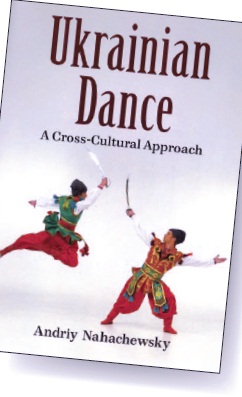 Andriy
Nahachewsky. Ukrainian Dance: A Cross-Cultural Approach (Jefferson, North
Carolina: McFarland & Company, 2012). ISBN: 978-0-7864-6168-4; USD $55.
Andriy
Nahachewsky. Ukrainian Dance: A Cross-Cultural Approach (Jefferson, North
Carolina: McFarland & Company, 2012). ISBN: 978-0-7864-6168-4; USD $55.Ukrainian
Dance: A Broader Perspective
 Andriy
Nahachewsky. Ukrainian Dance: A Cross-Cultural Approach (Jefferson, North
Carolina: McFarland & Company, 2012). ISBN: 978-0-7864-6168-4; USD $55.
Andriy
Nahachewsky. Ukrainian Dance: A Cross-Cultural Approach (Jefferson, North
Carolina: McFarland & Company, 2012). ISBN: 978-0-7864-6168-4; USD $55.
Book Review by Andrij Makuch
This
is without a doubt the most informative work you can find about Ukrainian dance
in any language.
That
said, the book under review offers some challenges to the causal reader.
Firstly, it is an academic work that uses technical language and employs
theoretical constructs. Secondly, it is addressed to an audience interested in
dance per se rather than one interested specifically in Ukrainian dance.
But
the bottom line is that Ukrainian Dance: A Cross-Cultural Approach
provides readers with a vast array of insights into this art form that over
time has moved from a village pastime to a stage mainstay.
This
work very much reflects the personal and professional history of its author –
Andriy Nahachewsky, who holds the Huculak Chair of Ukrainian Culture and
Ethnography at the University of Alberta. It underlines the experience of
someone who has lived, loved (the experiential is evident) and learned
Ukrainian dance. Starting at a young age, the author went through the dance
ranks until he was teaching tantsi several nights a week as a teen and
young adult. When he entered the world of academe, he pursued the topic
further—and in a very serious way. This end result took well over a decade and
a half of effort and reflection.
A
revealing indication of the intimate element is the author’s look at “seven
specific dances” in an “Examples” subsection near the beginning of the book.
We go through Pavlo Virsky’s Hopak (ca. 1960);
to a 1992 hutsulka in Molodiatyne (near Kolomyia); to a Metelytsia
viucha performed in 1931 at the Metropolitan Opera by an ensemble under the
directorship of Vasile Avramenko; to a Zinchuk-Romaniuk wedding kolomyika
in Edmonton in 1988; to a kvadryl'
(quadrille) performed in Dibrovo-Lemino ca. 1955–59; to a pas
de deux from Swan River; and finally, to a a humourous rendition of Iz
syrom pryhory (Pyrohy with Cheese), performed by the Sopilka Dancers
at the Vegreville Ukrainian Festival in 1998. One does not cobble together such
a list by happenchance.
Nahachewsky’s
work touches on two broader concerns.
The first is the dull place that Ukrainian dance occupies in the general
dance world. The author’s populist viewpoint calls for a more level approach to
the evaluation of different types of dance. Beyond this is a recognition that
over time, Ukrainian dance has evolved to an elite level and truly deserves
greater appreciation.
The
second relates to the lofty place that Ukrainian dance occupies in the mental
landscape of Ukrainians in North America. In Canada alone, there are well over
250 schools and ensembles, ranging from beginners’ classes to semi-professional
groups. Several generations of community figures have been raised in or
socialized by their Ukrainian dancing experience. And virtually every active
Ukrainian on this continent – at least over a certain age – has at least one
direct or semi-direct personal story to relate to Vasile Avramenko (whittling
down the proverbial six degrees of separation down to three).
Yet,
there has not been a great deal of discussion about dance among Ukrainians
here. At one time, there was a semi-regular column (“Kolumn-yika”) in the
newspaper of the Ukrainian Canadian Students’ Union, Student, and
occasionally, pieces might appear on the pages of the newsletters put out by
provincial Ukrainian dance associations in the Canadian Prairies. Nahachewsky steps into this gap with a
broadly considered work on Ukrainian dance.
The
book is laid out in a very logical manner, although this is not entirely
evident from the chapter headings. Reading the “Book Structure” section of the
“Preface” is most useful.
In
its first part (Chapters 1–3), Nahachewsky’s book examines dance per se.
The second portion (Chapters 4–7) looks at the question of “vival” dance, which
can be categorized broadly as dance done for personal enjoyment. Ukrainian
peasant dance very much falls into this category, and is particularly
significant in that it provided the source for more formal dance forms at a
later time.
The
rest of the monograph deals with “reflective dance,” in other words, dances
executed with an awareness of the extension of its roots.
Without
getting particularly specific about the remainder of the book, we go though
national dance, recreational dance, educational folk dance, and finally
“spectacular dance,” which ratchets up the entire process and incorporates
elements of more formal dance – notably ballet – and takes the art form to
Moiseyev, Virsky, and well beyond.
The
upshot off all this: we are talking about an extremely broad and very
knowledgeable perspective on Ukrainian dance. It should appeal especially to
all those interested in Ukrainian dance or Ukrainian cultural dynamics even
though its specific target audience is people who study dance.
Andrij Makuch,
Canadian Institute of Ukrainian Studies, Toronto Office.
The Toronto
lecture and book launch for “Ukrainian Dance: A Cross-Cultural Approach” by
Andriy Nahachewsky will be on Tuesday, 8 May 2012 at 7:30 pm, UNF Community
Centre (145 Evans Ave.), sponsored by the UNF Toronto Library and Resource
Centre, DESNA Ukrainian Dance Company, and the Ukrainian Women’s Organization
of Canada - Toronto Branch.